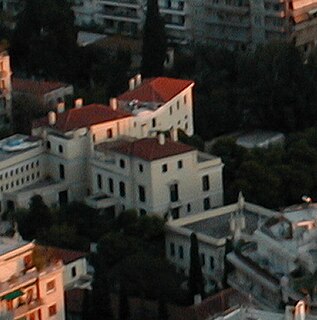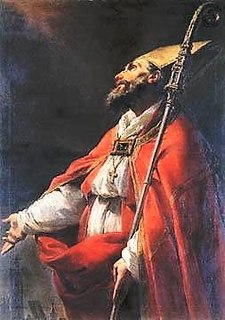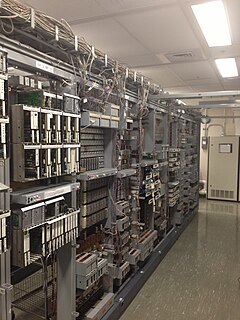Related Research Articles
In telecommunication, a cord circuit is a switchboard circuit in which a plug-terminated cord is used to establish connections manually between user lines or between trunks and user lines. A number of cord circuits are furnished as part of the switchboard position equipment. The cords may be referred to as front cord and rear cord or trunk cord and station cord. In modern cordless switchboards, the cord-circuit function is switch operated and may be programmable.

Gennadius II was a Byzantine philosopher and theologian, and Ecumenical Patriarch of Constantinople from 1454 to 1464. He was a strong advocate for the use of Aristotelian philosophy in the Eastern Church.

Saint Gennadius was the 21st Ecumenical Patriarch of Constantinople. Gennadius is known to have been a learned writer who followed the Antiochene school of literal exegesis, although few writings have been left about him. He is commemorated in the Orthodox Church on November 17, but is not listed in the Roman Martyrology.
Gennadius or Gennadios may refer to:
Gennadius of Massilia, also known as Gennadius Scholasticus or Gennadius Massiliensis, was a 5th-century Christian priest and historian.
Acmonia or Akmonia is an ancient city of Phrygia Pacatiana, in Asia Minor, now known as Ahat Köyü. It is mentioned by Cicero and was a point on the road between Dorylaeum and Philadelphia. Under the Romans, it was within the conventus iuridicus of Apamea.

The American School of Classical Studies at Athens (ASCSA) is one of 18 foreign foreign institutes in Athens, Greece. It is a member of the Council of American Overseas Research Centers (CAORC). CAORC is a private not-for-profit federation of independent overseas research centers that promote advanced research, particularly in the humanities and social sciences, with focus on the conservation and recording of cultural heritage and the understanding and interpretation of modern societies.
Islamic rule in Tripolitania and Cyrenaica began as early as the 7th century. With tenuous Byzantine control over Libya restricted to a few poorly defended coastal strongholds, the Arab invaders who first crossed into Pentapolis, Cyrenaica in September 642 encountered little resistance. Under the command of Amr ibn al-A'as, the armies of Islam conquered Cyrenaica, renaming the Pentapolis, Barqa.

Saint Petronius was bishop of Bologna during the fifth century. He is a patron saint of the city. Born of a noble Roman family, he became a convert to Christianity and subsequently a priest. As bishop of Bologna, he built the Church of Santo Stefano.
The Number Five Crossbar Switching System is a telephone switch for telephone exchanges designed by Bell Labs and manufactured by Western Electric starting in 1947. It was used in the Bell System principally as a Class 5 telephone switch in the public switched telephone network (PSTN) until the early 1990s, when it was replaced with electronic switching systems. Variants were used as combined Class 4 and Class 5 systems in rural areas, and as a TWX switch.
The Number One Crossbar Switching System (1XB), was the primary technology for urban telephone exchanges served by the Bell System in the mid-20th century. Its switch fabric used the electromechanical crossbar switch to implement the topology of the panel switching system of the 1920s. The first No. 1 Crossbar was installed in the PResident-2 central office at Troy Avenue in Brooklyn, New York which became operational in February 1938.

The Number One Electronic Switching System (1ESS) was the first large-scale stored program control (SPC) telephone exchange or electronic switching system in the Bell System. It was manufactured by Western Electric and first placed into service in Succasunna, New Jersey, in May 1965. The switching fabric was composed of a reed relay matrix controlled by wire spring relays which in turn were controlled by a central processing unit (CPU).

The Gennadius Library, also known as the Gennadeion, is one of the most important libraries in Greece, with over 110,000 volumes on Greek history, literature and art from Antiquity until modern times. The library is located at Souidias Street 61, on the slopes of Mount Lycabettus, in central Athens.
Marciana was a town in ancient Lycia, with a bishopric that was a suffragan of that of Myra.
Aureliopolis in Lydia is a city in the Roman province of Lydia, previously called Tmolus or in Greek Τμῶλος (Tmolos). It issued coinage under each of these names, and one coin combines both names. In the Synecdemus it appears as Auliou Kome. The name "Aureliopolis" was given in honour of the emperor Marcus Aurelius.
A junctor is a circuit used in analog telephone exchanges, including the Number One Crossbar Switching System, Number Five Crossbar Switching System, Panel switch, 1ESS switch and other switches.
Gennadius, sometimes referred to as Gennadius II, was a Byzantine general who exercised the role of Exarch of Africa from 648 to 665. In 664 Gennadius rebelled against Emperor Constans II and was himself overthrown the next year by a loyalist uprising.
Isidore II Xanthopoulos, was Ecumenical Patriarch of Constantinople from 1456 to 1462.
Sophronius I, was Ecumenical Patriarch of Constantinople from 1463 to 1464. The dates of his reign are disputed by scholars in a range from 1462 to 1464.
Panagiotes the Protopsaltes or Panagiotes the New Chrysaphes was a Greek composer, protopsaltes and poet in Constantinople, the capital of the Ottoman Empire.
References
- 1 2 "GlobIZ search". Global Information System on Pyraloidea. Retrieved 2011-09-29.CS1 maint: discouraged parameter (link)
- ↑ Beccaloni, G.; Scoble, M.; Kitching, I.; Simonsen, T.; Robinson, G.; Pitkin, B.; Hine, A.; Lyal, C., eds. (2003). "Gennadius junctor". The Global Lepidoptera Names Index . Natural History Museum . Retrieved May 4, 2018.